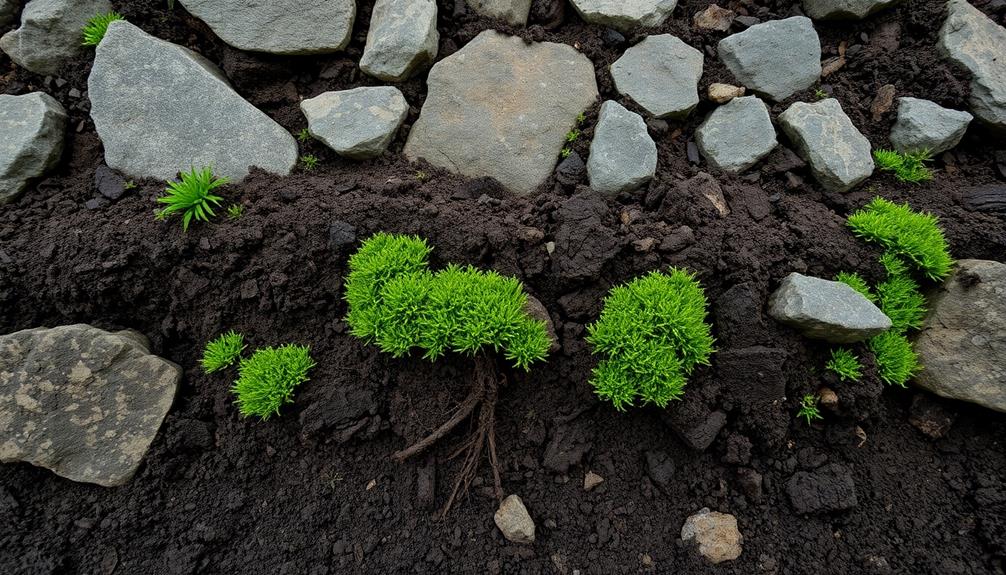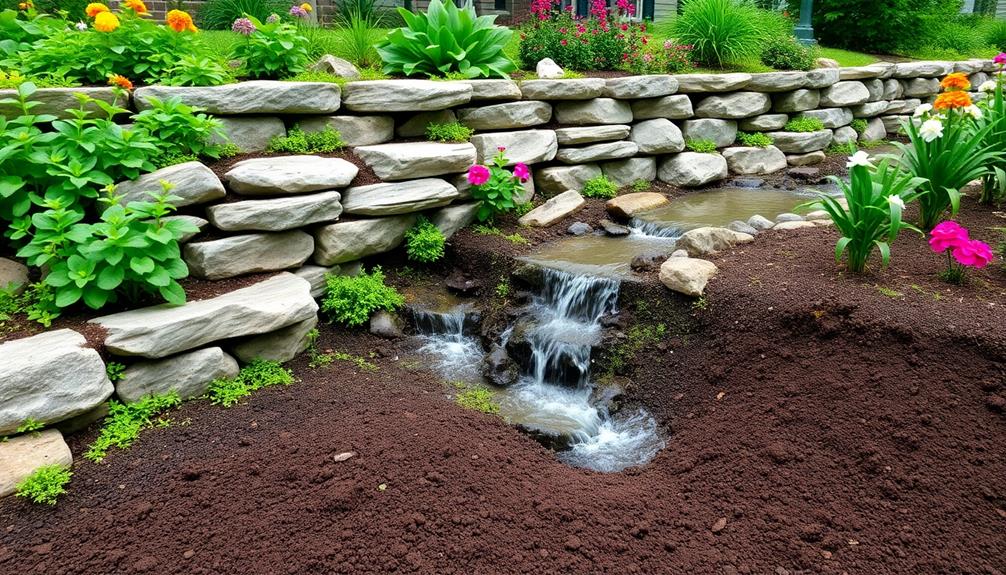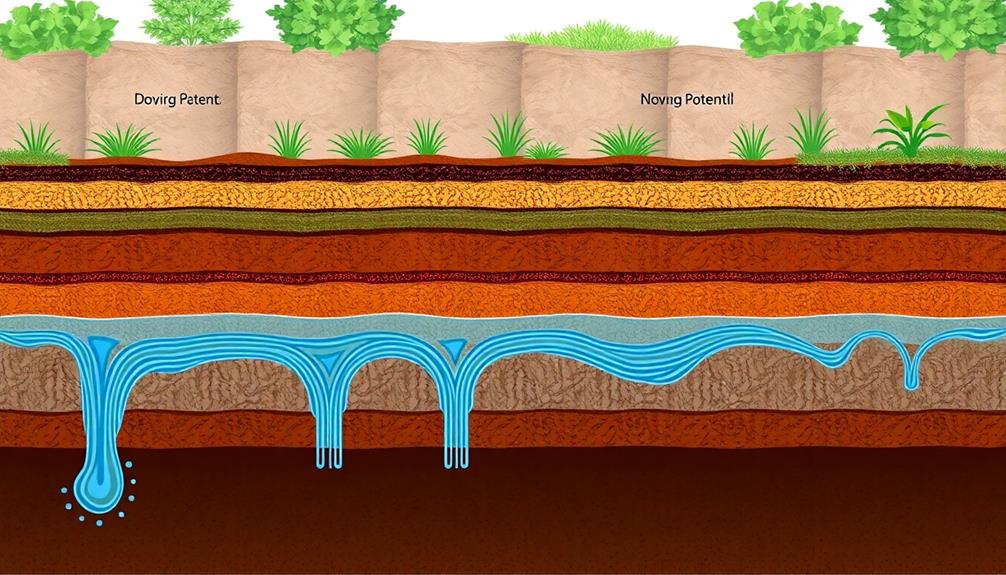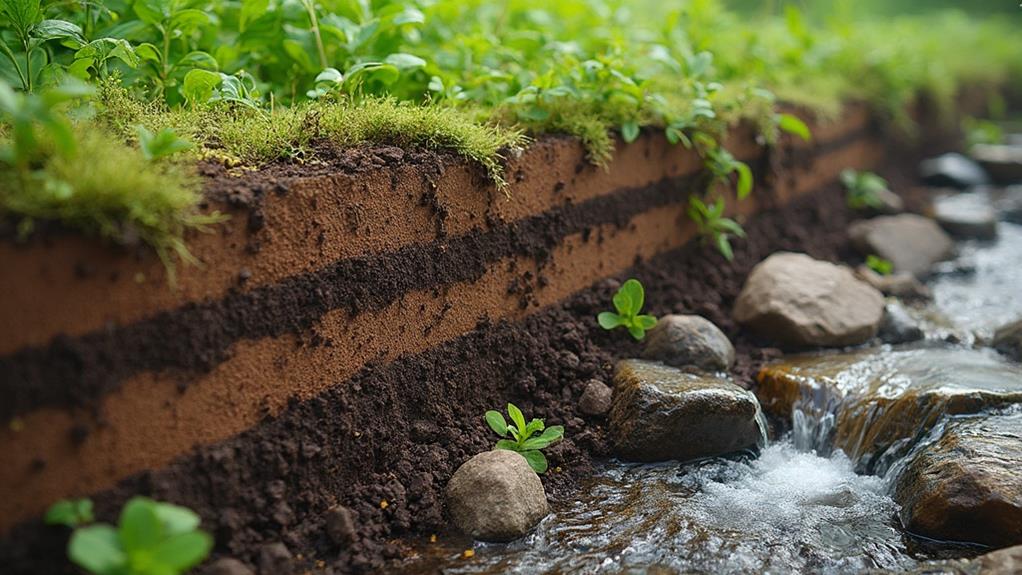Constructing a retaining wall requires a detailed understanding of soil type and drainage solutions to secure structural integrity and longevity. The choice of soil, whether sandy for its drainage efficiency or clay-based with its potential for high pressure buildup, directly impacts wall stability. Proper compaction is critical to enhance the soil's load-bearing capacity, while preventing moisture retention and erosion requires implementing robust drainage systems like perforated pipes and French drains. Geotechnical analysis is essential in tailoring soil compositions to guarantee uniform stability and effective water management. Consequently, examining these elements can fortify and extend the life of retaining walls.
Table of Contents
ToggleWalls Contractor Highlights
- Assess soil type for its impact on drainage, stability, and lateral pressure against the retaining wall.
- Ensure proper soil compaction to enhance load-bearing capacity and prevent settlement issues.
- Implement effective drainage systems, such as French drains, to manage water flow and reduce hydrostatic pressure.
- Utilize erosion control measures like vegetation and geo-textiles to protect against soil loss and maintain structural integrity.
- Conduct geotechnical analyses to tailor soil compositions and design reliable retaining wall structures.
Key Considerations for Soil

When constructing retaining walls, understanding the key considerations for soil is essential to guarantee structural integrity and functionality over time. Selecting the appropriate soil type is critical, as it influences drainage and the overall stability of the wall—sandy soils are generally preferred for their drainage properties, while clay soils may pose challenges due to poor permeability.
In addition to soil type, the choice of retaining wall materials can greatly affect the wall's durability and appearance. Additionally, proper compaction of the backfill material is required to enhance stability, and implementing erosion control measures can prevent soil degradation and water-induced failures, further supporting the longevity of the retaining structure.
Soil Type Selection
Selecting the appropriate soil type is essential in the design and functionality of retaining walls, as it directly impacts the structure's stability and drainage capabilities. The complex interplay between soil composition, weight-bearing capacity, and permeability necessitates careful consideration in choosing the right soil.
For instance, sandy soils are often favored for their high drainage potential, allowing water to percolate through without exerting lateral pressure on the wall. However, their low cohesive strength might demand additional stabilization measures.
Conversely, clay-based soils, while offering superior cohesive properties, present challenges due to their poor drainage and tendency to expand when wet, potentially leading to structural stress. Identifying a balance between these characteristics is vital in the selection process.
For a well-crafted retaining wall, the inclusion of granular backfill, typically comprising a mixture of gravel and sand, can enhance drainage and provide structural support. Understanding the local environmental context and geological conditions further refines soil selection, ensuring compatibility with the landscape and climate.
Incorporating geotechnical analyses, such as soil testing, allows for precise tailoring of soil compositions, achieving the delicate equilibrium necessary for the wall's longevity and performance, thus fostering a harmonious integration into its surroundings.
Compaction and Stability
Proper soil compaction is a crucial element in securing the stability and effectiveness of retaining walls. Through meticulous compaction procedures, the interlocking of soil particles is enhanced, which considerably improves the load-bearing capacity of the soil. As the soil beneath and behind a retaining wall is subject to immense pressure, the absence of adequate compaction may lead to uneven settling, ultimately jeopardizing the wall's integrity. Techniques involving mechanical compactors or rollers can be employed to achieve the necessary soil density, often measured in terms of the Proctor compaction test, which determines the optimum moisture content conducive to maximum density.
Stability, as linked to compaction, is not merely a single factor but an interconnected series of aspects, including the well-engineered design of the wall structure, the angle of repose of the soil, and the overall architectural integration with its surroundings. Identifying the soil's shear strength and elasticity is essential, facilitating proper load distribution and mitigating potential failure risks due to shear stress or hydrostatic pressure. Equally, understanding the permeability characteristics ensures that water does not erode the structural footing. This collaborative process is critical, creating environments that support and protect, ultimately ensuring the long-term success and belonging of the retaining wall within the landscape.
Erosion Control Measures
Addressing soil compaction and stability provides a foundation for understanding the critical importance of erosion control measures in retaining wall construction. Erosion control is paramount to prevent the gradual degradation of soils and the subsequent compromise of structural integrity. Measures must be carefully planned and implemented to not only protect the structural lifespan of the retaining wall but also to maintain the surrounding landscape's harmony and aesthetics.
To guarantee the effectiveness of erosion control, consider the following:
- Drainage Management: Effective drainage systems, like perforated pipes or French drains, are essential to channel water away from the wall, minimizing hydrostatic pressure and reducing soil displacement risks.
- Surface Protection: The use of vegetation, mulching, or geo-textiles helps stabilize the soil surface, reducing the impact of rainfall and runoff that could lead to erosive activities. These elements integrate the retaining wall into the landscape, fostering an innate connection with the environment.
- Structural Reinforcement: Incorporating retention mechanisms such as riprap, gabions, or tiered wall systems adds strength and stability, providing additional resistance to erosive forces by breaking their intensity over layered barriers.
Implementing these strategies not only secures the wall structurally but also reinforces community values by aligning with sustainable practices and fostering a sense of stewardship over shared spaces.
Benefits

Integrating well-considered soil and drainage solutions into retaining wall design considerably enhances structural stability by mitigating erosion and weakening forces. Boulder retaining walls hold the ground effectively over the long term due to their robust construction and strategic design.
Such systems efficiently prevent water accumulation, thereby reducing hydrostatic pressure that can compromise wall integrity while also fostering an environment conducive to robust vegetation growth, which itself adds a layer of stability through root structures. Additionally, thorough planning and incorporation of these elements serve to minimize maintenance demands over time, ultimately contributing to a more sustainable and effective retaining wall system.
Enhances Structural Stability
The incorporation of effective soil and drainage systems in retaining walls meaningfully improves their structural stability, a pivotal benefit for long-term durability and safety. All members of a community who value reliability in construction understand that proper drainage and soil composition minimize lateral pressure exerted on the wall. Integrating these systems reduces risks of failure while maintaining the integrity of surrounding landscapes. For those who cherish security in built environments, a well-engineered retaining wall provides peace of mind.
Consider these key aspects that highlight how enhanced structural stability is achieved through strategic soil and drainage considerations:
- Soil Composition: Utilizing suitable backfill, such as granular soil with good drainage properties, significantly decreases the hydrostatic pressure against the retaining wall. This improvement contributes to overall stability by facilitating water movement away from the structure.
- Drainage Implementation: Installing drainage pipes and weep holes allows for the efficient removal of excess water, a feature that further diminishes pressure build-up within the wall's structure.
- Compaction Techniques: Employing precise compaction methods during construction guarantees uniform soil density, effectively maximizing load-bearing capacity and minimizing settlement issues over time.
Together, these components form a cohesive system, essential in safeguarding the structural soundness of retaining walls. By prioritizing these factors, one is investing in a solid foundation for community spaces.
Prevents Water Accumulation
Effectively managing water through strategic drainage in retaining walls prevents the detrimental accumulation of moisture, offering numerous advantages for the longevity and performance of these structures. When water is left to pool behind retaining walls, it can increase the lateral pressure exerted on the wall, which could eventually lead to structural failure. By incorporating efficient drainage systems, such as perforated pipes or weep holes, this pressure is extensively alleviated, thereby fortifying the wall's integrity and reducing maintenance costs over time.
Moreover, preventing water accumulation through well-planned drainage solutions decreases the risk of frost heave in colder climates. Frost heave occurs when water freezes and expands, exerting enough upward force to crack or shift the wall structure. By ensuring proper water flow away from the retaining wall, these potential damages can be mitigated, contributing to a more robust and reliable construction.
Additionally, reducing water buildup discourages the growth and spread of mold and mildew within the materials themselves, preserving the wall's aesthetic and physical condition. This meticulous attention to drainage design ultimately fosters a safer environment for communities, promoting a shared sense of pride in well-maintained, durable landscapes.
Promotes Healthy Vegetation
How does proper drainage in retaining walls contribute to lush, thriving vegetation? Effective drainage plays a pivotal role in creating an environment conducive to healthy plant growth by managing water flow and preventing root damage. Retaining walls are more than structural enhancements; they support ecological harmony by ensuring vegetation receives the right amount of water.
Optimal Moisture Levels: Adequate drainage avoids waterlogging, a condition deterring plant growth by restricting air supply and root respiration. Properly designed systems allow excess water to escape, maintaining soil in a balanced, moist state favorable for vegetation.
Prevention of Soil Erosion: Well-constructed drainage systems reduce the risk of soil erosion, preserving the nutrient-rich topsoil essential for plant vigor. Erosion control in retaining walls therefore nurtures deeper roots and stronger plants.
Enhanced Air Circulation: By efficiently channeling water away, drainage facilitates improved air circulation within the soil. This encourages root aeration, a necessary component for absorbing nutrients and sustaining robust growth.
For those with a deep-rooted desire for greener landscapes, investing in proficient drainage solutions within retaining walls is indispensable. This harmonizes man-made structures with nature, fostering spaces where community, culture, and environment converge harmoniously.
Reduces Maintenance Needs
Moving from creating environments conducive to healthy vegetation, efficient drainage systems in retaining walls also dramatically reduce the need for ongoing maintenance. By expertly managing water flow, these systems mitigate the risks of erosion and waterlogging, two major factors requiring constant attention in standard wall constructions. Implementing these structures guarantees that the wall's integrity is consistently maintained, reducing the likelihood of costly repairs and the need for frequent oversight. This reliability is central to fostering a communal feeling of trust and security among neighboring property owners, knowing that their investments are protected with minimal intervention.
Moreover, these systems support the longevity of the retaining wall, as well-channeled drainage prevents soil saturation and subsequent wall destabilization. By minimizing the accumulation of hydrostatic pressure, the wall can stand resiliently against the elements, thereby avoiding common ailments associated with poor design, such as structural cracking or complete failure. The comprehensive protection and low-maintenance nature of efficient drainage solutions result not only in cost savings but also in time and effort, resonating with those who appreciate hassle-free environments. Ultimately, this strategic integration allows communities to relish the beauty and structure of their surroundings without the burden of continuous upkeep.
Local Soil Type Variation

Local soil type variations substantially affect the design and effectiveness of retaining walls, primarily through their influence on water flow patterns and the associated impact on wall stability. Different soil compositions, such as clay, sand, and silt, exhibit distinct properties that determine how water drains through and around the structure, thereby necessitating tailored engineering solutions. The table below highlights key differences in soil compositions and their implications for retaining wall stability and drainage needs.
| Soil Type | Influence on Water Flow | Impact on Wall Stability |
|---|---|---|
| Clay | Slow drainage | High pressure buildup |
| Sand | Rapid drainage | Lower lateral pressure |
| Silt | Moderate drainage | Moderate stability concerns |
| Loam | Balanced drainage | Balanced stability |
Influence on Water Flow
Understanding the influence of local soil type variation on water flow in retaining walls is pivotal for effective drainage administration. Soil characteristics directly affect how water percolates and disperses, impacting the performance of retaining walls immensely. Depending on the soil type—ranging from sandy, silty, clayey, or loamy—each variation dictates distinct water retention and drainage properties that require judicious consideration.
The rate at which water passes through soil is highly variable. Sandy soils, for instance, offer higher permeability, allowing for rapid drainage, whereas clayey soils retain water longer, hindering efficient flow and increasing hydrostatic pressure on retaining walls.
The granule size and compactness of soil impact water flow. Coarse-textured, loose soils facilitate greater movement of water, while finely textured, compacted soils may resist drainage, leading to potential pooling issues.
This characteristic describes the void spaces between soil particles. Highly porous soils enable better water movement, which is beneficial for maintaining judicious foundation conditions, unlike less porous soils that impede water transit and can exacerbate erosion around the retaining structure.
Recognizing these influences guarantees that the interaction between soil and water is managed to support not only functional but also sustainable retaining wall systems that align with the community's infrastructure goals.
Impact on Wall Stability
Soil type variation not only influences water flow but also plays a significant role in the stability of retaining walls. The unique properties of local soils, including their cohesion and internal friction, directly impact how well a wall can withstand lateral earth pressures.
For instance, clay-rich soils may hold moisture, increasing their weight and exerting greater pressure against a retaining structure, potentially compromising its integrity. On the other hand, sandy soils, while generally more free-draining, may lack the cohesion necessary to maintain wall stability under certain conditions.
Understanding the specific characteristics of the soil where a retaining wall will be constructed is essential in engineering a reliable structure. Geotechnical assessments often include detailed analyses of soil stratification, enabling engineers to guarantee potential challenges and mitigate them through appropriate design solutions. These may include reinforcing the wall structure or altering the drainage systems to accommodate the local soil's behavior.
In fostering a sense of community among stakeholders, it is critical to involve them in discussions regarding soil assessments and retaining wall designs. Shared insights into local soil conditions not only guarantee the longevity of retaining structures but also promote a collective understanding and responsibility for the integrity and safety of the built environment.
Soil Composition Differences
Frequently overlooked, the diverse composition of soil types across different regions substantially influences the effectiveness and longevity of retaining walls. This variation can present both opportunities and challenges for engineers and builders, who must meticulously assess the local soil conditions to guarantee structural integrity and prevent premature failure. Soil composition dictates drainage capabilities, compaction potential, and susceptibility to erosion—factors pivotal in the planning and construction phases of retaining walls.
When considering regional soil composition differences, several critical elements must be examined:
- Soil Texture: Soils range from sandy, which drains quickly, to clayey, which retains water and can lead to hydrostatic pressure against retaining walls. The texture affects the choice of materials and the design approach employed.
- Soil Density and Compaction: Denser soils may provide more stability but could also pose challenges in achieving ideal compaction needed to support a retaining wall. Proper compaction techniques must be tailored to each soil type to enhance structural reliability.
- Soil Moisture Content: The inherent moisture content of the soil affects its plasticity and load-bearing capacity, requiring careful analysis to anticipate changes during wet or dry conditions which could impact wall performance.
Understanding these factors fosters a sense of belonging among project stakeholders, aligning efforts towards a common goal of utilizing soil characteristics effectively for enduring structures.
Walls Contractor FAQ
How Does Soil Type Affect the Longevity of a Retaining Wall?
Soil type substantially impacts a retaining wall's longevity by influencing stability and drainage. Cohesive soils like clay retain water, increasing pressure, while sandy soils improve drainage, reducing stress on the structure, thereby fostering durability and community safety.
What Are the Signs of Poor Drainage in Retaining Walls?
Signs of poor drainage in retaining walls include water pooling near the base, visible cracks, soil erosion, leaning or bulging structures, and efflorescence. Addressing these issues promptly guarantees stability and longevity, fostering a safe and cohesive environment.
How Often Should Drainage Systems in Retaining Walls Be Maintained?
Routine maintenance of drainage systems in retaining walls is essential to guarantee their longevity and efficiency. Ideally, annual inspections and cleaning should be conducted, though specific frequency might depend on environmental conditions and the wall's usage intensity.
Can DIY Solutions Effectively Improve Drainage Behind Retaining Walls?
DIY solutions can enhance drainage behind retaining walls when executed meticulously. Engaging in proper research and community advice fosters effective implementation, ensuring ideal drainage performance while promoting a sense of accomplishment and belonging within the DIY community.
What Are the Best Materials for Drainage Layers in Retaining Walls?
Selecting suitable materials for drainage layers within retaining walls is essential for community unity in landscape design. Preferred options include gravel for ideal water flow, geotextiles to prevent soil migration, and perforated pipes for efficient drainage management.







